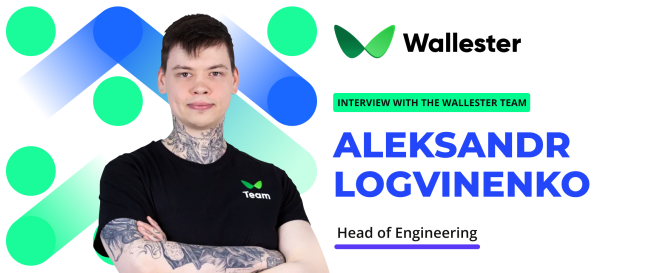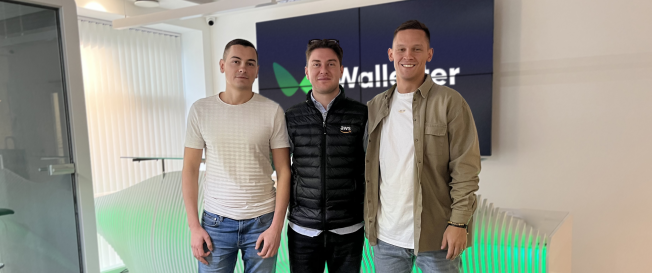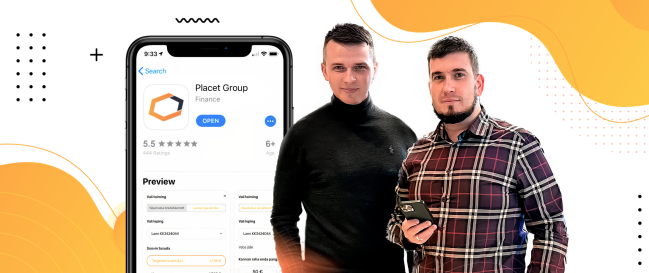We are excited to present an exclusive interview with Aleksandr Logvinenko, who, starting today, proudly takes on the role of the Head of Engineering at Wallester, a leading European fintech company known for its cutting-edge financial solutions.
In this interview, Aleksandr will be sharing his experience at Wallester, providing insight into the principles of the team-building process, some common challenges faced by beginning IT specialists, his vision for the future of financial technology as a whole, and much more.
This interview is a valuable opportunity for those interested in the tech industry to gain insight into the inner workings of a successful company and learn from a leader in the field.
Hello, Aleksandr, and thank you for taking the time to speak to us today! Please give us a brief introduction to who you are and your role at Wallester.
Hello, everybody! My name is Aleksandr Logvinenko, and I hold the position of the Head of Engineering at Wallester. I have been at the company since its inception. Well, almost; Wallester is six years old, and I’ve been here for five years. Nevertheless, I have first-hand experience witnessing the organisation’s growth from the early stages of product development to becoming one of the leading VISA enablers in Europe.
As the Head of Engineering, my primary responsibility is to be in charge of developing and maintaining Wallester’s system and its architecture. In simpler terms, I have to ensure that all the company’s IT processes are working like a Swiss clock.
What about your IT background? Specifically, how did you get started, and how did it lead you to Wallester?
It all started around 13 when I was actively playing video games. Through this passion, I got into running and managing multiplayer servers for various games. Working with game servers meant I had to write many scripts and other code forms, which sparked my initial interest in IT. At that stage, I was learning to code independently with whatever guidance and resources I could find online, accompanied by lots of trial and error.
As the years went on, my passion for IT grew stronger. In 2018, when I was doing my bachelor’s degree in Cyber Security Engineering, I was approached by my brother, Dmitri Logvinenko, who invited me to try putting my skills and passion for using, as well as learn more about IT and grow as a professional. What he referred to at the time was the construction of the project that would later be known as Wallester.
That’s fascinating. So you were part of the company before it was even known as Wallester. Could you tell us more about your journey with #TeamWallester, then? What was your starting position and your responsibilities at the time?
Yes, when I joined Wallester, the company only existed for about a year and was still in the early stages of its development, with around ten people employed.
Initially, I was just an IT intern trying to prove that I belonged in the team and could work on a project of this level of complexity.
After one month of showcasing my capabilities, the existing team decided to take me on board as a Junior Software Developer, and this is where it all started for me.
At first, my responsibilities included helping develop new features and fixing bugs. I did that for about a year before stepping out of the junior position and becoming a Software Developer, which meant more responsibilities. After another year, I became a Lead Software Engineer, shifting the focus towards leading others and taking it a step further two years later when I became a Technical Lead, which led me to my current position as the Head of Engineering.
And during that time, was a specific project that stood out to you the most?
I would have to say that the setup of Wallester’s 3D Secure system is my most notable project. I was introduced to the BPC team, our 3DS partner, and allowed to lead the integration project from start to finish. We completed the set integration when our team was still relatively small; hence, I was on my own. The task was quite challenging but definitely rewarding.
Being solely responsible for a project of this magnitude sounds like an intense experience. You have to have some practical ways to unwind. How do you enjoy your downtime? What are the go-to hobbies you enjoy outside of work?
Downtime is a wrong term in IT; I don’t enjoy it (laughs). But allowing yourself some free time is definitely essential, even if it’s not much. And if we are talking about my free time, I go to the gym and plan to start doing Brazilian Jiu-Jitsu in February.
What about video games, the hobby that introduced you to IT? Do you still play?
I have less time to play video games now, but I still do.
Any game in particular?
Well, the last thing I played was Horizon Zero Dawn on PS5. I did enjoy it quite a bit.
But if we go back to work, what do you think has been your most significant career achievement so far?
My most significant achievement is the speed of my career growth. As in just five years, I was able to go from a Junior Software Developer to the Head of Engineering role. It’s not something you see that often in the industry.
Of course, I would primarily attribute this achievement to the hard work I’ve put in, specifically, working overtime and sacrificing sleep to excel. Nevertheless, I also think that rapidly growing projects such as Wallester are just way more conducive to this type of growth.
That’s true. Companies that experience rapid growth are also promoting the similarly paced development of their employees. Why do you think newly graduated developers would find working in a team like yours especially exciting?
First and foremost, I sincerely believe that Wallester has an exciting product that is hard to find in the labour market for junior developers today. So I think our policy regarding junior incubation will be of great interest if you are looking to kick-start your career.
We have experience helping professionals grow, as people with limited knowledge have come to us in the past, mastered the craft, and now hold high-ranking roles within the organisation.
We really see Wallester as somewhat of an IT academy, and in return, this approach rewards us with gifted young minds that have fresh ideas and innovative methods of achieving things. And as stated prior, this professional development is set to happen way faster than in most giant corporations.
How many people are on your team right now, and what has been your biggest lesson on leadership so far?
Currently, my core team comprises 11 talented individuals who have taught me a lot about how to be an effective leader. The most important thing to remember is that every team member requires an individual approach to establish the best communication flow that would allow for the best performance and personal growth, which leads the whole team to success.
What are the core team-building principles, in your opinion?
The core team-building principle from the leader’s perspective, and one that people often forget, is to actually be a part of the team, meaning that you don’t take on the persona of the boss, elevating yourself above the others. Instead, treat your subordinates as equals regarding problem-solving and decision-making.
I would also say that clearly communicated responsibility is of great importance, as with it in place, people are encouraged to manage their own tasks and be more independent overall.
Finally, building an effective team with no sense of humour would be pretty hard, as it’s an excellent tool to lighten the atmosphere at difficult times. I believe those three factors play an essential role in the team-building process.
We understand sometimes you are running on tight deadlines. How do you stay organised while managing yourself mentally?
Within any fintech company, there are two core sectors: business and technology. Those sectors are great at working together, as one pushes the other. In practice, this means that we are always busy trying to turn ideas of the business sector into reality. High traffic of projects means that the company has a clear picture of where it wants to go, which is good. However, for us, it means constant development and tight deadlines. And there is only one way to meet set deadlines – hard work.
To manage your mental health amid all this work, you must look after your physical health, as the two are closely related. Doing sports, eating healthy, and getting good sleep, among others, is critical.
What about task prioritisation? How do you decide what is more important and what can wait?
Of course, you have to set different priority levels for your tasks, from low priority to high. In reality, however, you are often left with 20 “urgent” tasks a day, and the only way to manage that is by putting them all in one ordered list and going top-down rather than trying to select something more or less critical.
The trends in tech are constantly evolving. How do you stay current, and where do you find your sources of inspiration?
Tech is a very fast-paced field, and to stay on top of it all, I am trying to constantly educate myself, whether by reading scientific articles, watching educational videos, or learning practical examples of how other companies are structured.
Additionally, my everyday work at Wallester greatly contributes to my industry knowledge. We constantly face some exciting challenges and have to make sure that our solutions will come in the most advanced form, going in line with the market or even one step ahead.
What are some of the most exciting trends in tech & FinTech that you’ve seen lately? Anything you just can’t wait to get your hands on?
I am fascinated by how cards as payment instruments are developing. For example, the accessibility trend that we are seeing now with Thales offering voice payment cards for the blind, which are regular payment cards, but they are voicing all the actions of the payment process into the headphones of the user. I really like this idea of building products for the user’s convenience.
Similarly, I am inspired by the direction in which Apple Pay is going, as now they are enabling payments, issuing cards, and offering the Buy Now Pay Later service. Apple Pay is becoming a complete banking system preinstalled on your phone, which is an exciting shift for the whole field.
Why Wallester?
Wallester is a rapidly-growing project. After being here for so long and investing so much of myself into this company, it’s a pleasure to see this sort of development.
The secret of Wallester is quite simple. People here are incredibly hard-working, and that’s all there is to it. No magic or luck, just correctly set goals that are achieved with the help of our hard-working team.
We would be delighted to meet with you and discuss your business case, and explore how we can be of assistance.
Don’t hesitate to reach out to us through this contact form.
Our team is always happy to help you in any way we can.


